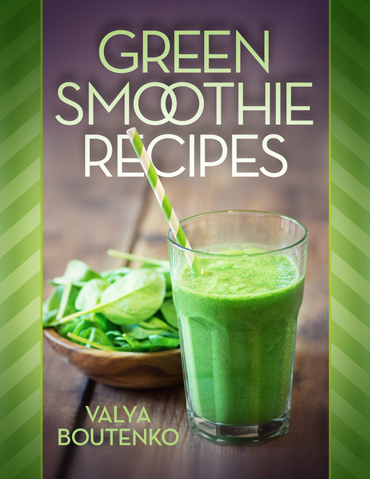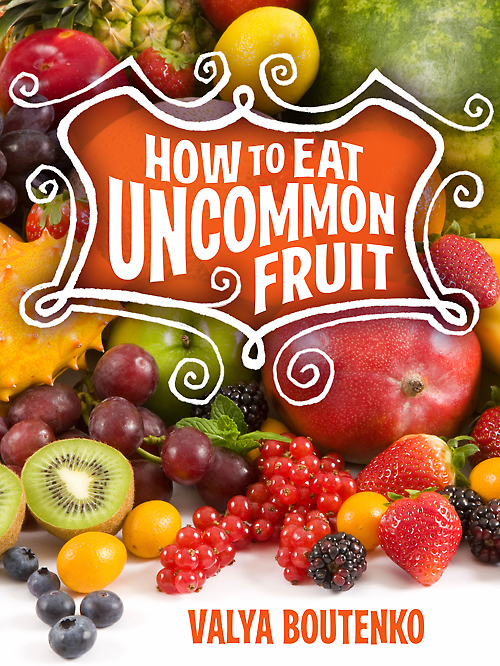The First Green Smoothie
By Victoria Boutenko
For decades dietitians have been educating the public about the multiple benefits of greens, but it was not clear how to incorporate fresh greens into everyone’s daily diet. The only option for eating greens seemed to be the salad. The problem is that in our industrialized world, the taste of greens is not as appealing as the stimulating taste of processed foods. That is why despite the Popeye cartoons and Jolly Green Giant advertisements in the 1920’s, mothers pushing broccoli on their children, wheatgrass shots in juice bars and a variety of green powders becoming available, greens remained a nonessential side dish or even an unpleasant requirement for many. That was also true for me. I knew I needed to eat greens but disliked the taste of them.In 2004, I had already been eating a raw food diet for more than ten years and although switching to an all raw diet had allowed me to reverse my most serious conditions - edema, arrhythmia, and depression - I still wasn’t experience the most vibrant health that I was looking for.
In search of the perfect human diet, I decided to look for an animal genetically close to human beings. I found that chimpanzees share an estimated 99.4% of their genes with humans. At the same time, these animals possess an extremely strong natural immunity to AIDS, Hepatitis C, cancer, and other fatal human illnesses. I was thinking that if we share 99.4% the same genes, our diets are supposed to be 99.4% similar. It appeared that the opposite was true. That is, the standard American diet is about 99% different from the diet of wild chimpanzees. Please see for yourself.

The Standard American Diet is almost 100% cooked or processed, while the diet of chimpanzees is 100% raw and whole foods. As you can see from the charts below, even the diet of the typical raw foodist resembles the diet of chimpanzees by only 50%.
When I recognized how many greens we humans are supposed to consume daily, it became clear to me that I had to come up with an utterly new approach. From the study of human anatomy I learned that for the best possible absorption, the greens have to enter the digestive tract in liquefied form. Greens are high in cellulose which makes them difficult for the digestive system to break down. In perfectly healthy human bodies and with the absence of nutritional deficiencies, the greens are liquefied by two processes; first, by thorough chewing and then by being mixed with stomach acid. Unfortunately, many people today don’t have normal levels of hydrochloric acid due to mineral deficiencies, particularly zinc.
You may request your doctor to perform a stomach acid test on you. I would like to share with you an observation that might help you to decide whether or not you have low stomach acid. The average person probably has experienced vomiting several times in their life. If you ever vomited as a child maybe you remember that the acids from your stomach burned your throat, to such an extent that it hurt for several hours. Maybe you can compare this experience with another incident of vomiting later in your life. Do you remember whether or not the burning sensation was still present or was weaker or not felt at all? That might be an indication of a reduced hydrochloric acid level in your stomach.
People who cannot chew their food and who have low hydrochloric acid eventually stop enjoying greens and even develop a distaste for them. I understand that this is a defense mechanism of the human body. As if it is telling us “honey, you are not able to digest these greens and they only become a burden on your digestive system, so I’m going to make you nauseous so you stop eating greens completely.” It is a vicious circle. As humans consume more processed food they become increasingly deficient in nutrients. Being unable to create stomach acid, they stop consuming greens and become even more deficient. Their health continues to deteriorate.
At the time when I was researching the details of digesting greens, I was already missing my most important molars, and my stomach acid was extremely low. Naturally I started looking for a way of liquefying large quantities of greens. At first I decided to blend dark leafy greens in a high-speed blender. However, after I did so, when I opened the lid I had to quickly close it as the smell was unbearable. I knew right away that I couldn’t possibly drink that mixture. At the same time I knew that I was on the right track. Blender after blender was poured into the compost. Several days passed before I came across a paragraph in Jane Goodall’s book about chimpanzees in which she mentioned that sometimes chimpanzees would take a fruit, role it in a green leaf, and eat it as a sandwich. I stared at that paragraph thinking it was poor food combining according to human research. Then I thought that maybe chimps know better. Later I came to the conclusion that greens were erroneously placed in the wrong category as vegetables. There is a substantial difference between green leaves and vegetables. Green leaves don’t have starch while vegetables such as carrots, beets, broccoli, zucchini, daikon, etc., contain a lot of starch. Starchy vegetables combined with fruit may cause bloating. Contrary to that, fiber in green leaves helps slow the absorption of sugar in fruit making this combination beneficial.
That discovery marked the beginning of my own green smoothie revolution. I peeled bananas and blended them with green kale. With trepidation I opened the lid of the blender and it smelled great. I tasted this super green drink and it tasted exactly like a banana smoothie. I was able to trick my body. I was consuming a large amount of greens without any resistance from my body or my taste buds. I didn’t feel nauseous. In fact, I ecstatically enjoyed the greens for the first time in my life!
As I was drinking the first green smoothie of my life, it dawned on me that my children could also enjoy eating greens this way. And my friends. And my neighbors. And my coworkers. And my students. And, oh my goodness, the whole world too! At this point I started dancing in my office and then in the street. I couldn’t stop laughing and shouting with delight. I recognized that green smoothies were a perfect solution for people like me, of whom there were millions.
This is a chapter taken from Victoria's book Green Smoothie Revolution ©2009 Copyrighted material Please reference this source when sharing this information: www.rawfamily.org
Resources
Blenders & Deydrator:- High Speed Blender: Vitamix
- Travel Blender: Tribest
- Dehydrator: Excalibur Dehydrator
- American Community Gardening Association: ACGA
- Organic Seeds including wild edible seeds: Seeds of Change
- Organic Farmers & Farmers Market Directory: Local Harvest
- Download No GMO Guide: The Non-GMO Shopping Guide
- Diabetes: Simply Raw: Reversing Diabetes in 30 days
- Cancer: Healing Cancer from Within
- Food Industry: Food Inc
- Wild Edibles: Earth Walks North West
- Research into natural cures for illness: Master Your Illness
- National Agriculture Library: USDA
- Raw Vegan Diet Research Links: Beyond Vegetarianism
- Ann Wigmore: www.annwigmore.org
- Jane Goodall: www.janegoodall.org
- Byron Katie: www.thework.com
- Krishnamutri: www.kfa.org
- Eckhart Tolle: www.eckharttolle.com
- Max & Charlotte Gerson: www.gerson.org
- Dear Diabetes Advisor, by Michael A. Pfeifer, M.D., CDE. Alexandria, Virginia: American Diabetes Association, 1997.
- Diabetes: Questions you have… Answers you need, by Paula Brisco. Allentown, Pennsylvania: The People’s Medical Society, 1997.
- Conquering Diabetes, by Anne Peters, M.D. New York: Hudson Street Press, 2005.
- American Diabetes Association Complete Guide to Diabetes. Alexandria, Virginia: American Diabetes Association, 2002.
- The Diabetes Problem Solver, by Nancy Touchette, PhD. Alexandria, Virginia: American Diabetes Association, 1999.
- Albi, Johnna and Walthers, Catherine. Greens Glorious Greens! New York: St. Martin’s Press. 1996.
- Appleton, Nancy. Rethinking Pasteur’s Germ Theory. California: North Atlantic Books. 2002.
- Baker, Elizabeth. Unbelievably Easy Sprouting! Washington: Elizabeth Baker. 2000.
- Baroody, Dr. Theodore A., Jr. Alkalize or Die. North Carolina: Eclectic Press. 1991.
- Brown, Ellen Hodgson,J.D. and Hansen, Richard T., D.M.D., FACAD. The Key to Ultimate Health. California: Advanced Health Research Publishing. 2000. 2^nd Edition.
- Campbell, T. Colin, Ph.D. The China Study. Texas: Benbella Books 2004.
- Cooper, Dr. Kenneth H. Advanced Nutritional Therapies. Tennessee.: Thomas Nelson, Inc. 1996.
- Cutrell, Doug and Wigmore, Ann. Living Foods Manual. New Mexico.
- Feldt, Linda Diane. Spinach and Beyond. Michigan: Moon Field Press. 2003.
- Fouts, Roger. Next of Kin. New York: HarperCollins Publishing. 2003 Reprint.
- Fuhrman, Joel, M.D. Eat to Live. New York: Little, Brown and Company. 2003.
- Gebhardt, Susan E. and Thomas, Robin G. Nutritive Value of Foods. Washington, D.C.: Superintendent of Documents U.S. Government Printing Office. 2002. Revised.
- Goodall, Jane. Reason For Hope. New York: Warner Books, Inc. 1999.
- Goodall, Jane. The Chimpanzees of Gombe. Massachusetts: The Belknap Press of Harvard University Press. 1986.
- Goodall, Jane. Through a Window. Boston: Houghton Mifflin Company. 1990.
- Harris, Ben Charles. Eat the Weeds. Connecticut: Keats Publishing, Inc. 1973.
- Jensen, Bernard, DC, Ph.D. Come Alive! California: Bernard Jensen, 1997.
- Jensen Bernard, D.C., Ph.D. Tissue Cleansing Through Bowel Management, Escondido, CA: Bernard Jensen Publishing, 1981
- Kliment, Felicia Drury, The Acid Alkaline Balance Diet. New York: Contemporary Books, 2002.
- Krishnamurti. Think on These Things. New York: Harper & Row Publishers. 1964.
- Ladygina-Kohts, N.N. Infant Chimpanzee and Human Child. New York: Oxford University Press, Inc. 2002.
- Ley, Beth M. PhD. Flax! Fabulous Flax! Minnesota: BL Publications. 2003.
- Mindell, Earl, R.Ph., Ph.D. Food as Medicine. New York: Simon & Schuster. 1994.
- Peterson, Lee Allen. Edible Wild Plants. New York: Houghton Mifflin Company. 1977.
- Price, Weston A., D.D.S. Nutrition and Physical Degeneration. California: The Price-Pottenger Nutrition Foundation, Inc. 2003. 6^th Edition.
- Ragnar, Peter. How long do you choose to live? Tennessee: Roaring Lion Publishing. 2001.
- Ross, Julia, M.A. The Diet Cure. New York: Penguin Books. 1999.
- Ruimerman, Ronald. Modeling and remodeling in bone tissue. Eindohoven: University Press Facilities. 2005.
- Seibold, Ronald L. M.S. Cereal Grass. Kansas: Pines International, Inc.2003.
- Shahani, Khem, Ph.D. Cultivate Health from Within. Connecticut: Vital Health Publishing, 2005.
- Stanway, Dr. Andrew. The High-Fiber Diet Book. New York: Exeter Books. 1976.
- Tompkins, Peter and Bird, Christopher. Secrets of the Soil. Anchorage, Alaska: Earthpulse Press Inc. 2002. Third Printing.
- Tompkins, Peter and Bird, Christopher. The Secret Life of Plants. New York: Harper & Row, Publishers. 1989. First Perennial Library Edition.
- Tooshi, Dr. Alan M., Ph.D. Dr. Tooshi’s High Fiber Diet. Nebraska: iUniverse.com, Inc. 2001.
- Van Orden, Dr. Flora. Conversations with Dr. Flora. TheRawDiet.com. 2005.
- Wigmore, Dr. Ann and Earp-Thomas, Dr. G.H. Organic Soil. Massachusetts: Rising Sun Publications. 1978.
- Wigmore, Ann. Overcoming Aids. New York: Copen Press. 1987.
- Wigmore, Ann. Rebuild Your Health. Puerto Rico: Quality Printers. 1991.
- Wigmore, Ann. You Are The Light Of The World. Massachusetts: Ann Wigmore. 1990.
- Wigmore, Ann and Pattinson, Lee.The Blending Book. New York: Avery Publishing Group. 1997.
- Winick, Myron, M.D. The Fiber Prescription. New York: Ballantine Books. 1992.
- Young, Robert O. and Shelly Redford. The pH Miracle. New York: Warner Books, Inc. 2002.















































